John Saunders Taylor, USN, CSN, CSA
27 May 2018
At the very end of his life, in combat on the open ground south of the Miller Cornfield at Sharpsburg, John S. Taylor was entirely fearless ...
He was born in Norfolk, Virginia in 1820 to a family with a tradition of military service. His grandfather John Saunders had been a US Army Major General, and his great-grandfather Celey Saunders commanded the Virginia State Navy ship Thetis (1778) in the Revolution.
He began his own career in December 1836, then 16 years old, when he joined the US Navy.
Just as surely dead
8 October 2012


Arthur F. Hascall, (c, 1861, NY State Military Museum)
I’m scrubbing through unit rosters, regimental histories, and many other documents as part of the Antietam Roster Project. Most of the listings are sketchy and dry, and when I have the chance, I like to dig a little deeper for more information to flesh out the individuals who were at Antietam.
An example of how this sometimes goes, with a bit of an unexpected twist, is the case of Sergeant Arthur Hascall of the 61st New York Infantry.
Patrick Clooney, 88th New York
22 January 2011
There’s a large and active group among students of the American Civil War fascinated with the service of Irishmen in the conflict, and with the Irish Brigade of the Army of the Potomac in particular. There’s a vast amount of lore and legend on the subject, which I’ve only really noted in passing. I know … and with my surname, too.
So it is with some trepidation that I dig here into the life and passing of Patrick Phelan (Felan) Clooney. One of those heroes of the Irish Brigade at Antietam.
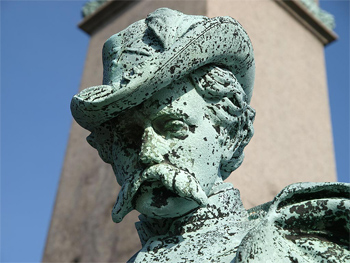

detail from the Soldiers Monument, Calvary Cemetery, Queens, NY (2009, biostheoretikos.com)
I am prompted by an effort underway to rescue a memorial to Clooney in his native Waterford. Thanks to James Doherty, who is fund- and awareness-raising, and Damian Shiels, who brought him to my attention…
The Newf and Werner von Bachelle
9 January 2011

(Janet Richmond, via Flickr)
This is the stone at Antietam National Cemetery for Captain Werner von Bachelle, killed in action on 17 September 1862 at Antietam. He’s something of a celebrity today. School kids hear of him in their packets at the cemetery and battlefield. Though he died a brave soldier, like so many others that day, that’s not why he’s so well known. He owes his celebrity to his dog.
In April 1861 von Bachelle volunteered with his local militia, the Citizens Corps of Milwaukee, for service in response to President Lincoln’s first call for troops. In May the officers – Capt. William Lindwurm, 1st Lt. Frederick Schumacher, and 2nd Lt. Werner Von Bachelle – were commissioned in Federal service and their unit became Company F of the new 6th Regiment of Wisconsin Volunteer Infantry. Like von Bachelle, nearly all of the men of the Company were German speakers, most German born …
The Liljenquist photographs and Sharpsburg
31 December 2010
I have been busy with the business of life, but not entirely ignorant of the world outside! I certainly noticed the October 2010 announcement of the incredible generosity of the Liljenquist family who donated their collection of more than 700 Civil War ambrotypes and tintypes to the Library of Congress. The Library is creating a physical exhibit for them opening in April 2011 as part of the Sesquicentennial observations.
In the meantime, they’ve scanned and posted the collection online on their own pages and through a Flickr photostream. I’ve explored this treasure a little, and found some intriguing images with connections to our favorite battlefield.
![[Unidentified woman wearing mourning brooch and displaying framed image of unidentifed soldier] (LOC)](https://live.staticflickr.com/5201/5228622401_284617d66c.jpg)
Woman wearing mourning brooch and displaying framed image of soldier (1861 – 1865, Library of Congress via Flickr)
I’m sorry that so few of the subjects of these pictures are identified. Only a couple of dozen are named, another dozen or so are identified by military unit from clues on their uniforms or in the photo background. The remaining hundreds are unidentified.
I am moved all the more, however, by the anonymity of this woman in her grief. I presume from the context that the soldier in her lap has recently been killed. Her husband? It reminds me again of the deadly way the War ripped through families and brings perspective to battle maps, memorials and markers …
Dr. Howard and Hooker’s foot
13 February 2010
Because he was conspicuous on his white horse and close to the battle-front on the morning of Wednesday, 17 September 1862 near Sharpsburg, Maryland, perhaps it was inevitable that Major General Joseph Hooker would be killed or wounded in the ferocious combat there.
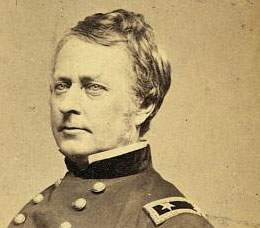
Major General Joseph Hooker (c. 1862, Library of Congress)
And wounded he was. Although it is fantasy to speculate, there were those who thought the battle of Antietam would have gone differently had Hooker not been knocked from command of the Federal First (I) Army Corps by a bullet through the foot at about nine o’clock that morning.
Sharpsburg, September 20, 1862.
MY DEAR HOOKER: I have been very sick the last few days, and just able to go where my presence was absolutely necessary, so I could not come to see you and thank you for what you did the other day, and express my intense regret and sympathy for your unfortunate wound. Had you not been wounded when you were, I believe the result of the battle would have been the entire destruction of the rebel army, for I know that, with you at its head, your corps would have kept on until it gained the main road. As a slight expression of what I think you merit. I have requested that the brigadier-general commission rendered vacant by Mansfield’s death may be given to you. I will this evening write a private note to the President on the subject, and I am glad to assure you that, so far as I can learn, it is the universal feeling of the army that are the most deserving in it.
With the sincere hope that your health may soon be restored, so that you may again be with us in the field, I am, my dear general, your sincere friend,
GEO. B. McCLELLAN,
Major-General.
Looking into the nature of the General’s injury led me in a somewhat different direction, however – toward learning about the medical care he received, and more about the life and career of his doctor, Assistant Surgeon Benjamin Douglas Howard, USA …
David Hunter Strother on Antietam
14 January 2010
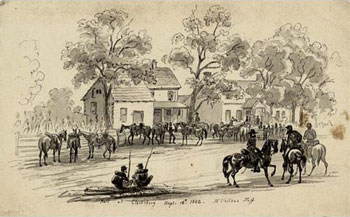
Halt at Clarksburg, Sept 12th 1862, McClellan’s Staff (DH Strother, 1862)
David Hunter Strother (1816 – 1888) – writer, artist and Federal officer – was on General George McClellan’s staff on the Maryland Campaign of 1862. His creative skills resulted is some fascinating artifacts of that period, which I’m enjoying in my study of Antietam and its participants.
Born in Martinsburg, (now West) Virginia, he had trained as an artist in New York and Europe, and was working as a writer and illustrator in books and magazines in his 20’s. His father “Colonel” John – an Army Lieutenant 1813 to 1815 – ran the Strother House hotel in Berkeley Springs.
By the 1850’s D.H. was famous as “Porte Crayon” – his nom de plume. He was on assignment for Harpers Weekly at Harpers Ferry in 1859 and covered John Brown’s trial and execution …
Antietam vets go West
6 October 2009
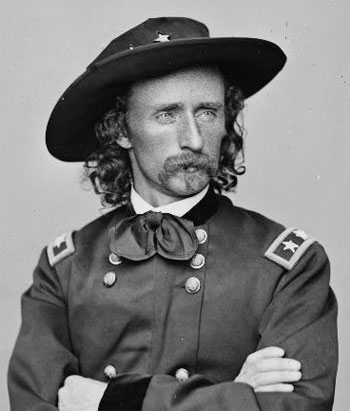
G.A. Custer (c. 1865, Library of Congress)
I’ve just been reading a brand-new edition of Dee Brown’s Bury My Heart at Wounded Knee, out just last month from Sterling Publishing. It’s a beautifully packaged and illustrated version of the landmark 1970 work, which looks at the West from 1860-90. I recommend it highly.
While the main point of the book is the Indian experience, of course, some of the prominent actors in the story jump out at me because they were also veterans of the Battle of Antietam. Which is a good excuse to find some post-War photos of a half-dozen of these men and catch up a little with their later careers …
John Westbrook at Antietam
28 August 2009
There are half a dozen unfinished posts waiting in the queue for this (very occasional) blog, but I am prompted to actually publish one at last by some fascinating email correspondence from Marianne Tierney, whose great-great-grandfather John Westbrook you see here. Marianne and her cousin Art Van Allsburg have collected and have shared some family treasures concerning their ancestor and Antietam.
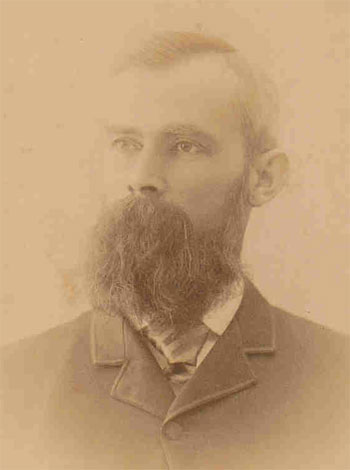

John Westbrook (postwar, courtesy M. Tierney)
This photograph is magnificent, but more exciting is a letter written by Marianne’ s grandfather Van Allsburg in 1964 which recalls what he heard from his grandfather Westbrook firsthand. With it, and some other tidbits I’ve dug up, we can follow something of this soldier’s life through and following the catastrophic Battle of Antietam …
Gold from another mine
5 March 2009
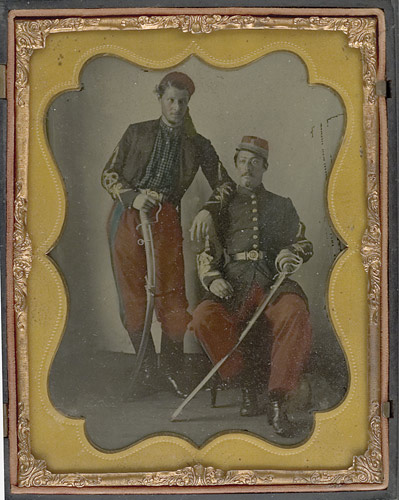
M.A. and G.A.G. Coppens (1861, from Cowan’s Auctions)
This stunning piece is a rare image of two Louisiana Zouaves, one of whom was killed in action at Sharpsburg. It is among a trove of pictures of “my boys” I’ve harvested from the web in the last few days – thanks to Cowan’s, Heritage, and Museum Quality Americana auction houses.
I’ve ranted in the past about our history disappearing into the hands of private collectors (and it’s still a shame this stuff isn’t in public repositories), but I’m mostly reconciled to that. As long as firms like Cowan’s continue to make their archives of past sales available on the web, I think they’re acting in some ways as digital museums – and doing us a great service.
I’ll be pushing more than 20 of these new-to-me images of Antietam/Sharpsburg participants to AotW over the next few days. Among some of the most compelling is the lovely tinted half-plate ambrotype above, along with a crisp CDV and a mustering-out group photograph below …


